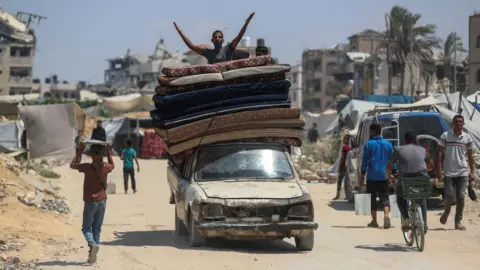In a significant development amid ongoing hostilities, Hamas has reportedly accepted a ceasefire proposal that was facilitated by regional mediators, primarily Egypt and Qatar. This information was disclosed by a source within the Palestinian armed group to BBC News. The backdrop of this proposal is the relentless conflict between Hamas and Israel, which has persisted for over 22 months, leading to devastating humanitarian consequences in Gaza.
The ceasefire plan, as detailed by a Palestinian official familiar with the negotiations, is a two-phased arrangement, building on a framework introduced by U.S. envoy Steve Witkoff. According to this proposal, Hamas would release approximately half of the 50 Israeli hostages currently held, with around 20 believed to be alive. This release would occur in two stages, paralleled by a temporary truce lasting 60 days. During this ceasefire, discussions are proposed to continue concerning a permanent ceasefire agreement and the withdrawal of Israeli troops from Gaza.
Despite the announcement from Hamas, Israeli officials have yet to respond. The intensity of the conflict has recently escalated, prompting many citizens in Israel, particularly in Tel Aviv, to rally and demand that their government reach an agreement with Hamas to secure the return of the hostages. This public demonstration involved hundreds of thousands who expressed their frustration with the ongoing situation. Prime Minister Benjamin Netanyahu, however, has voiced his objections, claiming that the protests could harden Hamas’s position in negotiations.
The context of this ceasefire proposal arises from a complicated backdrop of military strategies and public sentiment within Israel. Netanyahu’s administration had previously indicated that any deal would require the simultaneous release of all hostages, which sharply contrasts with the gradual plan highlighted in the recent proposal. Adding to the tension, reports suggest that Israel’s cabinet is poised to approve plans for a largescale military expansion in Gaza, focusing particularly on Gaza City. This decision follows the collapse of earlier indirect negotiations concerning a ceasefire, which broke down last month.
Amid these developments, it is essential to acknowledge the grave humanitarian crisis resulting from the conflict. Since the onset of intense hostilities—triggered by a Hamas-led assault on southern Israel that resulted in the deaths of approximately 1,200 people and the abduction of 251 others—over 62,004 individuals have lost their lives in Gaza, according to the Hamas-run health ministry. This staggering number highlights the dire need for a resolution to the ongoing conflict, which has exacerbated the humanitarian catastrophe faced by the Palestinian population.
As these negotiations unfold, the implications extend beyond just the immediate conflict. A potential ceasefire could pave the way for renewed discussions about long-term stability in the region, although skepticism remains regarding the intentions of both parties. Hamas’s willingness to engage in a truce could be seen as a tactical maneuver in the face of mounting pressure from the international community and the general population in both Israel and Gaza.
The continual spiral of violence, negotiation breakdowns, and ongoing military strategies underline a complex reality where lasting peace seems elusive. As efforts toward a ceasefire intensify, the world watches closely, hoping for a respite from the violence that has claimed so many lives and left countless individuals suffering in both Gaza and Israel. Future actions by both Hamas and the Israeli government will likely shape the trajectory of this protracted conflict, with significant ramifications for the region’s stability.












